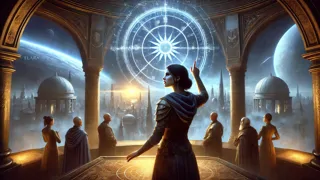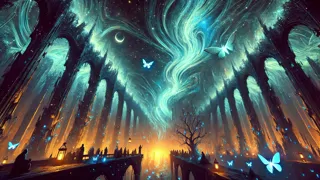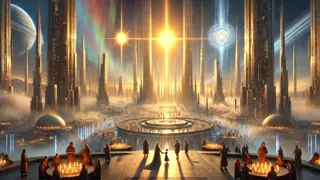Introduction
On the planet Astralis, sunlight is more than a gift—it is the essence of existence itself. Imagine a world stitched together from golden prairies, sapphire lakes, and crystalline mountains, all basking eternally in the brilliance of four radiant suns. Each sun, named after a virtue—Dalus, Veyra, Solenne, and Cael—waltzes across the sky in an intricate dance, their combined light never truly relinquishing its hold. Shadows are faint, the night is a forgotten word, and children grow without ever learning to squint away from darkness. The land teems with color: iridescent fauna, phosphorescent forests, and fields that shimmer in a mosaic of life. Calendars mark time not in days but in sun-cycles, weaving light into the very rhythm of civilization. Homes are built with translucent spires, cities spiral upward to embrace every golden hour, and even fields of wheat seem to exude a syrupy luminescence beneath the overlapping rays. In every woven tapestry, every oral history recited at aurora festivals, one tale looms larger and darker than all the rest—the legend of Nightfall. It's a whispered myth, told to skeptical children and prudent scholars, about the possible alignment that, once every thousand years, will blot out the four suns, plunging Astralis into a darkness deeper than memory. But in this era, such a legend is almost an absurdity, a relic from a superstitious past. Who could possibly fear the night, when existence itself has never known it? Yet among Astralis’s gleaming spires, one astronomer, Elara, senses the subtle shift in orbits, the barely measurable tremor in ancient scripts. She alone studies the sky not for its light, but for the long-shadowed truth written in its heart. As the thousandth year approaches, Elara’s findings send a ripple of apprehension through the luminous calm. As Astralis unknowingly stands on the threshold of its first night, Elara must unravel cosmic secrets, face the shadows of fear and myth, and lead her world into the unknown. The planet that has never slept is about to dream—and perhaps, to awaken in ways it never imagined.
The Eclipse Approaches: Anxieties of Light and Shadow
Elara Shira’s life had been a tapestry of light—her earliest memory was not of standing, but of squinting. She grew up beneath the glass domes of Lysium, Astralis’s capital, where even dusk could be chased away at will. Her curiosity, however, didn’t settle for the obvious. Where others found comfort in certainty, she found intrigue in oddity: the slightly offbeat hum in the symphony of light, the way stars subtly shifted in the farthest reaches of sunrise.

In the grand Hall of Observers, among rows of silver-eyed scholars, Elara hunched over her starmap. The marble floor reflected four shifting sunlight patterns, and yet her focus was on the whisper-thin lines of prediction. She compared ancient glyphs etched into timeworn tablets—no one but the oldest Scribes could translate the pre-Light tongue, but Elara had taught herself. Each day revealed data she hoped she’d miscalculate, an astronomer’s guilt for what she could not prevent.
The mathematical models grew more alarming. She saw it unfolding: an unprecedented alignment, where all four suns would pass behind the planet’s twin moons, casting Astralis into utter darkness. For the first time in a millennium, every blade of grass and city spire would be starved of light. She computed the cycle, triple-checked: one thousand years, give or take a few hours of margin. Nightfall was not myth. It was imminent.
Word spread, first as a scholarly oddity, then as an anxious rumor. Lysium’s Council convened, and Elara was summoned to explain her findings. The vast chamber, usually filled with laughter and commerce, now buzzed with an undercurrent of fear. Councilor Zerrin, a city-builder and life-long friend, asked the question that lingered on every tongue: “How will our world endure…without light?”
Some argued for panic. Some accused Elara of doomsaying. Others dug up the old fables—the ones about Night’s Beasts, about the chilling embrace that could swallow a soul. But a quiet majority listened as Elara spoke of preparation. "Light has always been our shield. Now, courage must be our lantern," she declared. She urged investments in sunstores—huge batteries that could capture and store radiant energy. Teams worked night and day (the irony not lost on them) to finish emergency lighting, to simulate warmth for crops, to ease children’s terror.
In Lysium and beyond, the surface buzzed. People painted windows with glimmerleaf, a resin said to hold sunlight. Musicians composed light symphonies, attempting to anchor joy. Yet tension simmered. Faiths fractured: the Sun-Chosen accepted Nightfall as divine trial; the Shadelings stirred, followers of old superstitions predicting that ancient shadows would reclaim what belonged to night. Some retreated into underground enclaves, clutching relics from the time before Light.
Elara herself—reluctant icon of this new era—felt the weight of hope and dread. Nights (if one could call them so) found her sleepless, watching the orbits inch closer to their fateful alignments. Through telescopes trained at the heavens, she saw the winking gaze of the twin moons, felt the pulse of approaching darkness. One night, while walking beneath the overlapping suns, she was approached by a cloaked figure—the enigmatic Eno, a Shadeling scribe. "When dark comes," he rasped, "some things crawl from the cracks. Your lamp will not always banish them."
Elara studied his haunted expression and realized Nightfall was more than a physical threat; it would bare Astralis’s fears and test the very soul of its people.
She set out to unite Lysium—not as a scientist, but as one voice among millions. In the last week before the fourfold eclipse, a thousand tasks frayed her days: advising power engineers, speaking at mass vigils, calming families whose children sobbed at the receding light. Countless times she was asked, “What does darkness truly mean?” She gave the only answer she believed: “It is what we make of it.”
As the final solar cycle ticked down, Astralis teetered at the edge of legend. The cities glowed as bright as ever, yet beneath the brilliance, everyone sensed the gravity of what was to come—the moment when familiar daylight would finally surrender to Nightfall.
Night Beyond the Suns: Shadows Awake
The moment Nightfall arrived, an uncanny hush blanketed Astralis. The four suns—so constant in the sky that few truly knew how to track their passage—sighed beneath the lunar occlusion. The first sign wasn’t darkness itself, but the absence: shadows that sharpened, colors desaturating, a coldness creeping in where warmth and brilliance had always been. One after another, Dalus, Veyra, Solenne, Cael vanished. The landscape, for the first time in memory, turned a trembling shade of blue-black.

In Lysium, the city’s grand towers and spiral causeways dimmed as emergency sunstores were unleashed. The glow was eerie—mechanical, spectral, unable to simulate true day. Children clung to their mothers; the old wept for reassurance. Lightbenders ran through the streets, tending to lamps as if tending to wounded soldiers, urged on by priests who recited prayers meant for a world without uncertainty. Despite every invention and every plan, people knew this light was only imitation—and somehow, every small sliver of shadow looked deeper and more alive than before.
Elara paced the city, her heart a metronome of anxiety and awe. She found friends and strangers huddled in parks, eyes wide, listening for any sign that the fabled Beasts of Night might emerge. For generations, stories painted darkness as a living terror—a shadowed thing that devoured worlds, the price for hubris. Yet as the hours passed, it was loneliness that pressed closest, not monsters.
Away from Lysium’s nerves, the forests glowed faintly with the last embers of sun-drunk flora. In the hinterlands, Nomads gathered around bioluminescent mushrooms and shared stories—how once, before records began, Astralis was not always light. They told of a time when creatures navigated by touch and song. Now, some of those creatures stirred again. No one could forget the fluttering wispwings—small, ethereal moths, heretofore sleeping in waiting, now awoken in their multitudes. Their wings shimmered silver in the manufactured glow, forming rivers of light that meandered through the silence.
But not all was peaceful. In the crypt-village of Damaris, old hatreds reawakened. The Shadelings, once ostracized for their obsession with darkness, now saw themselves as protectors—keepers of balance. Eno tried to quell the fervor, arguing that Nightfall was neither curse nor judgment. Some of his followers, though, saw their moment:
“If the world must know darkness,” they cried, “let us teach them.”
An attempt was made to sabotage the sunstores. In the chaos, Lysium’s oldest archives—a library built to trap the fourfold light—burned, its secrets lost to gasping night. Elara, desperate to prevent disaster, intervened. She braved the clinging shadows, a mere lamp her only defense, and found Eno in the ruined archives.
Tears streaked his face. “We wanted the world to listen...and now we risk its destruction.”
Together, they led a group to restore failed circuits and re-light Lysium. In the process, they found odd comfort: in shared fear, there was unity. Survivors formed circles, not out of panic, but to trade warmth, food, comfort, and whispers of encouragement.
Outside the cities, things were stranger. Mystery animals, dormant for ages, began to emerge—hushed silhouettes that never belonged to a world of light. Tiny night-hoppers darted through the frost, glowing like embers as they leapt. The flora shimmered with hidden pollen, exuding fragrances no one had ever smelled. The auroras pulsed madly, painting the dark firmament in rivers of color the likes of which even Astralis had not known. And in every direction, telescopes saw unfamiliar stars—constellations long washed away by sun glare.
For Elara, the revelation was profound. She sat atop the shattered library, head tilted towards the unfamiliar sky, and felt the ancient, mythic pulse of Astralis beat within her. "Darkness isn’t void," she whispered, "it’s discovery."
By the final hours of Nightfall, people had changed. Some saw danger—but most sensed opportunity. In the absence of their suns, Astralis had kindled a different kind of brilliance, one born not of fusion in the sky, but of understanding shared amidst the unknown. When the first sliver of dawn pierced the horizon, its light landed on a world no longer afraid.
Awakening from Night: A New Dawn for Astralis
As first light returned, it was nothing short of a revelation. It began as a faint glow—paler than memory, too soft for even the poets to name. The twin moons fell away, one after the other, until Dalus reclaimed the edge of the horizon. Then Veyra. Then Solenne and Cael, each igniting in sequence, gilding mountaintops, breaking apart the sea of shadow in shimmering shards. The world, starving for light, feasted hungrily.

In Lysium, people stepped from their refuges, some wincing at the return of true sunlight, as if eyes needed to relearn wonder. Children danced in golden puddles, trailing after the wispwings now folding back into myth. The devastation in the archives was matched by the hope that pulsed through the city—neighbors and strangers joined to sweep away the remnants of fear, to replant gardens, to string new lights from home to home.
Elara became, reluctantly, a symbol not of the past, but of the new Astralis: one who’d faced darkness without succumbing to it. She was urged to speak beneath the Triumph Arch, a spire at Lysium’s heart. Her voice rang out over a crowd spanning every caste, Sun-chosen and Shadeling alike. “We were never meant to live in only one kind of world,” she said, “nor to find bravery only in light. Let us remember what we saw in night: not just fear, but opportunity, new colors and stars, new ways to dream. We are more, now, than a people of sunshine.”
Yet true change went deeper than speeches. Scientists began to study nocturnal life, fascinated by the resilience and wonders hidden beneath perpetual glare. Mosaics commemorated the blooming of the auroras, the birth of mythic creatures, the courage of friends and enemies side by side in shadow. Faiths, once divided, found common ground: the Sun-Chosen and the Shadelings gathered together, not to debate, but to weave shared stories of Nightfall to guide generations ahead.
But the impact was not confined to Astralis alone. The planet’s astronomers, led by Elara and a now-redeemed Eno, mapped the night sky for the first time in memory. They discovered distant civilizations—signals, perhaps, or echoes of worlds that, too, grappled with their own eves. The stars spoke in riddles, yet every answer brought fresh questions. Astralis, once inward-looking, began to cast its gaze outward, daring to imagine, to hope, to connect with the wide and wild universe.
Technological leaps soon followed. Using knowledge learned during Nightfall, innovators created light-forging batteries and flora that could bloom even under intermittent sun. For the first time, Astralis designed homes that could shelter life in both day and night. Communities traced the art and culture born in shadow, and museums rose to celebrate not just the thousand years of light, but the singular night that united them.
Elara took solace among the new constellations, binoculars in hand. Eno often joined her. "You found what you sought," he mused. She smiled, gently. "We all did. We found ourselves."
So Astralis was never the same—not diminished, nor broken, but reborn. Memories of Nightfall became legend once more, retold not as warnings, but as testaments to courage, growth, and shared humanity. In the end, the world learned darkness wasn’t their downfall, but the place where their light was finally truly seen.
Conclusion
Nightfall left Astralis forever changed. In a planet ruled by confidence and routine, the taste of darkness brought humility, but also possibility. Elara’s journey—from solitary astronomer to reluctant unifier of a fractured world—stitched new threads into the planet’s consciousness. Every corner of Astralis, from gilded city towers to shadowed enclaves, bore the memory of enduring what was once unthinkable. The old fears—of monsters, of loss, of alienation—proved to be shadows themselves, dispelled by the common courage and curiosity the night ignited. From that epoch-making eclipse came a rediscovery: that strength is found in adversity, and wisdom in opening one’s heart to the unknown. Generations grew eager for each dawn, no longer fearing what lay beyond the four suns. Nightfall’s truth—etched in every starmap and sung in every anthem—became this: light is precious, but life’s true brightness often emerges when the world goes dark. So Astralis thrived, basking not just in sunshine, but in the radiant promise that even the longest night can bring a world together, lighting the way forward for all eternity. The legend of Nightfall, once a story of dread, became a celebration—a reminder that darkness is simply another form of hope, waiting to be revealed.

















